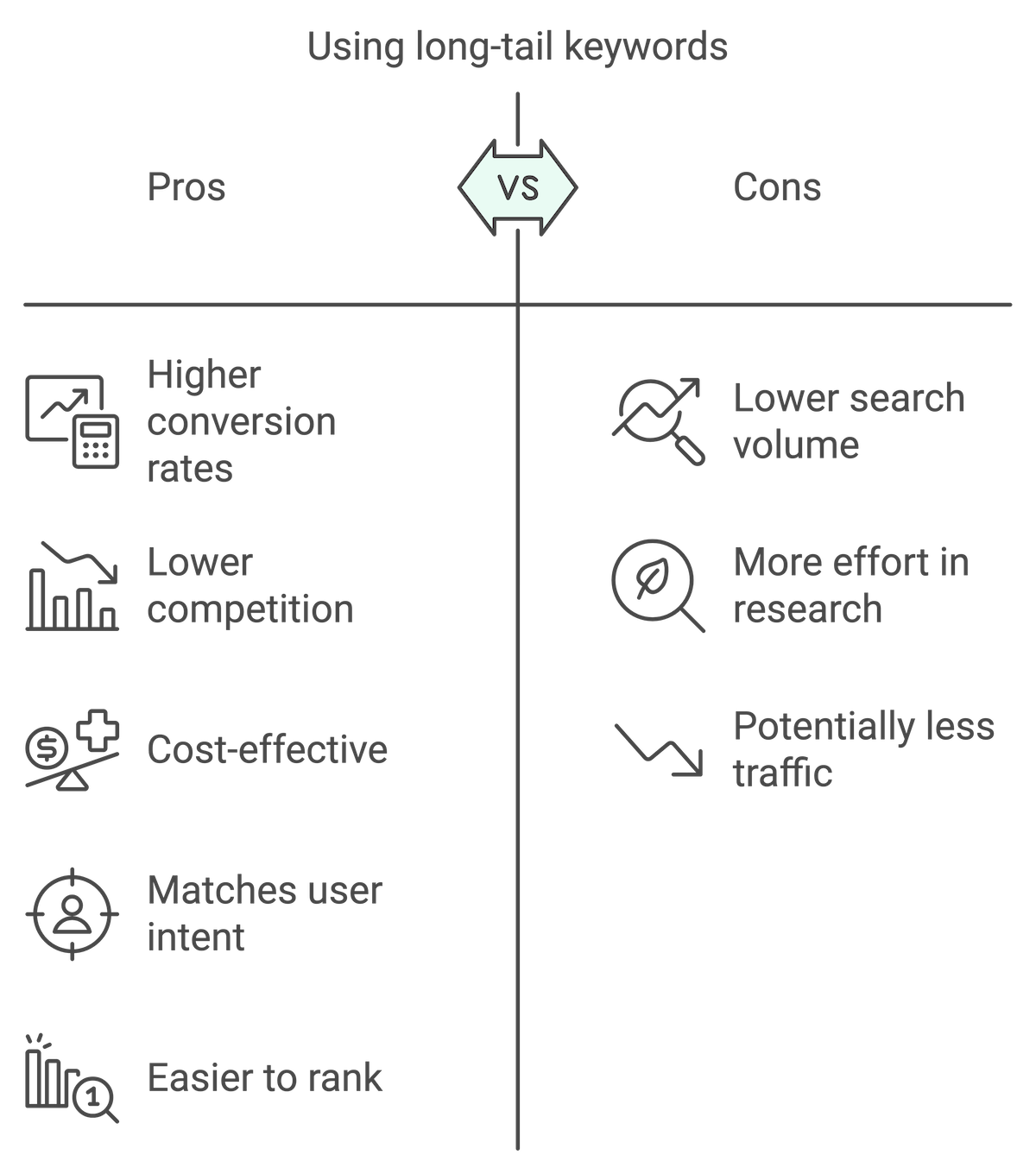Long-Tail Keywords: The Secret to Ranking Faster and Cheaper
By: Hayden Jarman

Ever feel like ranking your website is a constant uphill battle?
You’re not alone.
The competition for broad keywords is intense, and the cost can be astronomical. But what if there was a way to rank faster, spend less, and attract the exact audience you’re looking for?
There is.
It’s called long-tail keywords.
Let’s dive into why they work, how they’ll save you time and money, and how you can start using them today.
Table of Contents:
- What Are Long-Tail Keywords?
- Why Long-Tail Keywords Should Be Your Focus
- Finding Long-Tail Keywords
- How to Use Long-Tail Keywords for Results
- Benefits of Long-Tail Keywords
- Practical Tips for Long-Tail Keyword Success
- Internal Linking with Long-Tail Keywords
- Long-Tail Keywords Across Industries
- FAQs About Long-Tail Keywords
- Final Thoughts
🎓 Long-Tail Keyword Mastery Quiz 📊
Test your knowledge and get personalized tips to master long-tail keywords!
What Are Long-Tail Keywords?
Long-tail keywords are specific search phrases with three or more words.
Unlike broad keywords like “SEO services,” long-tail keywords focus on niche intent, such as “affordable SEO services for small businesses in Wilmington, NC.”
These keywords might not bring in millions of searches, but the ones they do attract are highly targeted and more likely to convert.
Here’s why they work: they answer specific questions, solve immediate problems, and match the way people actually search—especially with the rise of voice search.
Why Long-Tail Keywords Should Be Your Focus
Long-tail keywords dominate search queries.
They make up 91.8% of all searches, showing just how vital they are in matching user intent.
The cherry on top? They deliver higher conversion rates, averaging 36%, compared to 11.45% for broader terms.
And while everyone is busy fighting over high-competition keywords, you can slide into the rankings with these low-hanging fruits.
Finding Long-Tail Keywords
You don’t need to reinvent the wheel to find great long-tail keywords.
The right tools and strategies can make the process simple and effective.
Keyword Research Tools
Tools like Ahrefs, Moz, and Google Keyword Planner are your go-to for discovering actionable keywords.
For example:
- Broad Keyword: “Digital marketing.”
- Long-Tail Keyword: “Best digital marketing agency in Wilmington, NC.”
Analyze Competitors
Platforms like SEMRush let you spy on your competitors. See what keywords they rank for and find gaps you can fill.
Tap Into Your Audience
Check forums, social media, and FAQ sections. Pay attention to how people phrase their problems or questions.
If they’re asking, they’re searching.
How to Use Long-Tail Keywords for Results
Long-tail keywords don’t just belong in blog posts. They can enhance almost every part of your site.
Blog Content
Write posts targeting specific queries your audience is searching for.
Example: How to Rank a Website with Multiple Locations.
These types of posts bring in hyper-targeted traffic and answer real questions.
Product and Service Pages
Tailor your titles and descriptions to match long-tail keywords.
Swap generic phrases like “SEO services” for specifics like “affordable SEO services for Wilmington small businesses.”
Internal linking boosts the effectiveness here, too. Check out this guide on SEO Health Check.
Voice Search Optimization
With the rise of voice assistants, users phrase searches more conversationally. Match this style with long-tail keywords.
Example: Instead of targeting “best restaurants,” try “Where’s the best Italian restaurant near me?”
Benefits of Long-Tail Keywords
A Direct Comparison
| Metric | Broad Keywords | Long-Tail Keywords |
|---|---|---|
| Search Volume | High | Medium to Low |
| Competition | High | Low |
| Conversion Rate | ~11% | ~36% |
| Cost-Per-Click (CPC) | Expensive | Affordable |
Practical Tips for Long-Tail Keyword Success
- Focus on user intent. Don’t just choose keywords that sound good—pick ones that match what your audience is actually looking for.
- Write conversationally. Match the way people naturally search, especially with the rise of voice search.
- Use internal links. They guide readers to more valuable content, like SEO-Friendly Website Development.
- Update content regularly. Fresh content ranks better and keeps your audience engaged.
Internal Linking with Long-Tail Keywords
Long-tail keywords aren’t just for your headers and meta descriptions. They work wonders as part of your internal linking strategy.
Here’s how:
- Link related blog posts to create a seamless journey for the reader.
- Example: A post about "SEO for service businesses" can link to Why Schema Is Important.
This isn’t just great for user experience; it’s also an SEO boost.
Long-Tail Keywords Across Industries
Let’s look at some examples:
| Industry | Broad Keyword | Long-Tail Keyword |
|---|---|---|
| Digital Marketing | SEO services | Affordable SEO services for small businesses |
| E-commerce | Yoga mats | Best eco-friendly yoga mats under $50 |
| Local Business | Car repair shop | Affordable car repair shop in Wilmington, NC |
FAQs About Long-Tail Keywords
What makes long-tail keywords better for SEO?
They’re easier to rank for, drive targeted traffic, and convert better.
Can I use multiple long-tail keywords on the same page?
Yes. Just ensure they fit naturally into your content.
Are they suitable for voice search?
Absolutely. They align perfectly with conversational queries.

Final Thoughts
Long-tail keywords are the easiest way to rank faster and cheaper while attracting the right audience.
They dominate search queries, convert better, and cost less.
If you’re ready to make them work for you, start integrating them into your content today.
For more insights, check out Using Near Me in SEO or explore our Digital Marketing Services.
Stop wasting time on high-competition terms.
Start winning with long-tail keywords.
Related Posts:
- Understanding Google’s Local Pack: How to Get Featured
- Google Business Profile FAQs: Everything You Need to Know
- The Best Google Ads Extensions to Boost Your Click-Through Rates
- How to Leverage Facebook Groups for Local Business Leads
- How to Use AI to Write Better Social Media Captions
- How to Optimize Google Reviews to Attract More Customers
- LinkedIn for B2B Marketing Success
- How to Conduct a Social Media Audit (w/ "Audit Readiness" Quiz!)
- Creating a Content Calendar for Consistent Posting
- The Importance of Mobile Optimization in 2024
- Data Privacy Regulations: What Marketers Need to Know
- The Role of Chatbots in Enhancing Customer Service
- SEO for Small Business: The Ultimate Guide to Getting Found Online
- The Role of Keyword Clustering in Modern SEO

